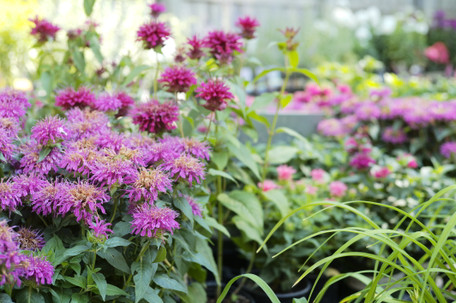Monarda
Posted by Aaron Barton on Jul 11th 2021
Monarda (Bee Balm/Wild Bergamot)
As the intense heat of summer continues, mid-season bloomers are flourishing and late summer bloomers are starting to show some color, offering a whole new assortment of bright colors and intoxicating aromas in the summer perennial garden. A common mid-season sight, bee balm, Monarda didyma (mo-NAR-duh DID-ee-muh), is a beautiful eastern North American native perennial and member of the mint family, Lamiaceae, that provides not only bright, beautiful color in the garden, but also fragrant, animal resistant foliage.
Ranging in height from 18-48" depending on variety, and spreading gently to form clumps 24-48" wide, Monarda provide an excellent variety of colors and sizes, making them a great choice for sunny border plantings, pollinator gardens, cutting gardens, and cottage gardens, looking their best when massed together in large plantings. Bee balm thrives in areas of part to full sun, preferring rich, moist soil, but will also tolerate a wide range of soil conditions as long as there is some moisture present. Monarda flowers span a colorful range of pinks, reds, and purples, including the lovely pink flowers of the compact ‘Grand Mum,' light purple flowers of the compact ‘Grand Marshall,’ lavender flowers of ‘Grand Parade,’ and bright raspberry blooms of ‘Raspberry Wine.’
Additionally, the Minnesota native Monarda species, Monarda fistulosa (mo-NAR-duh fiss-t-you-LOW-sa), also known as wild bergamot, is excellent for larger home landscapes, pollinator gardens, and natural areas. Maturing to 36-48" tall, wild bergamot blooms beautiful light lavender flowers beloved by native pollinators. Forming larger stands over time if allowed to spread, spent bloom heads can be removed to prevent seed dispersal and limit spread, and plants are also easily pulled or may be divided as needed to keep clusters tidy and well-behaved in the landscape.
Flowering from mid-summer through late summer, Monarda blooms stand atop fuzzy square stems and are comprised of multiple arching tubular flowers which radiate from the center of the flower head outward concentrically, often framed by specialized showy leaves, called bracts. As their name suggests, bee balm flowers are a favorite of bees, among many other pollinators, especially hummingbirds and butterflies which prefer their long, tubular flower structure.
After flowering, plants can be deadheaded to promote reblooming, or toward the end of the season, spent blooms may be left to develop into interesting seed heads for winter interest and food for local songbirds through the cold winter months.
Happy Planting!

